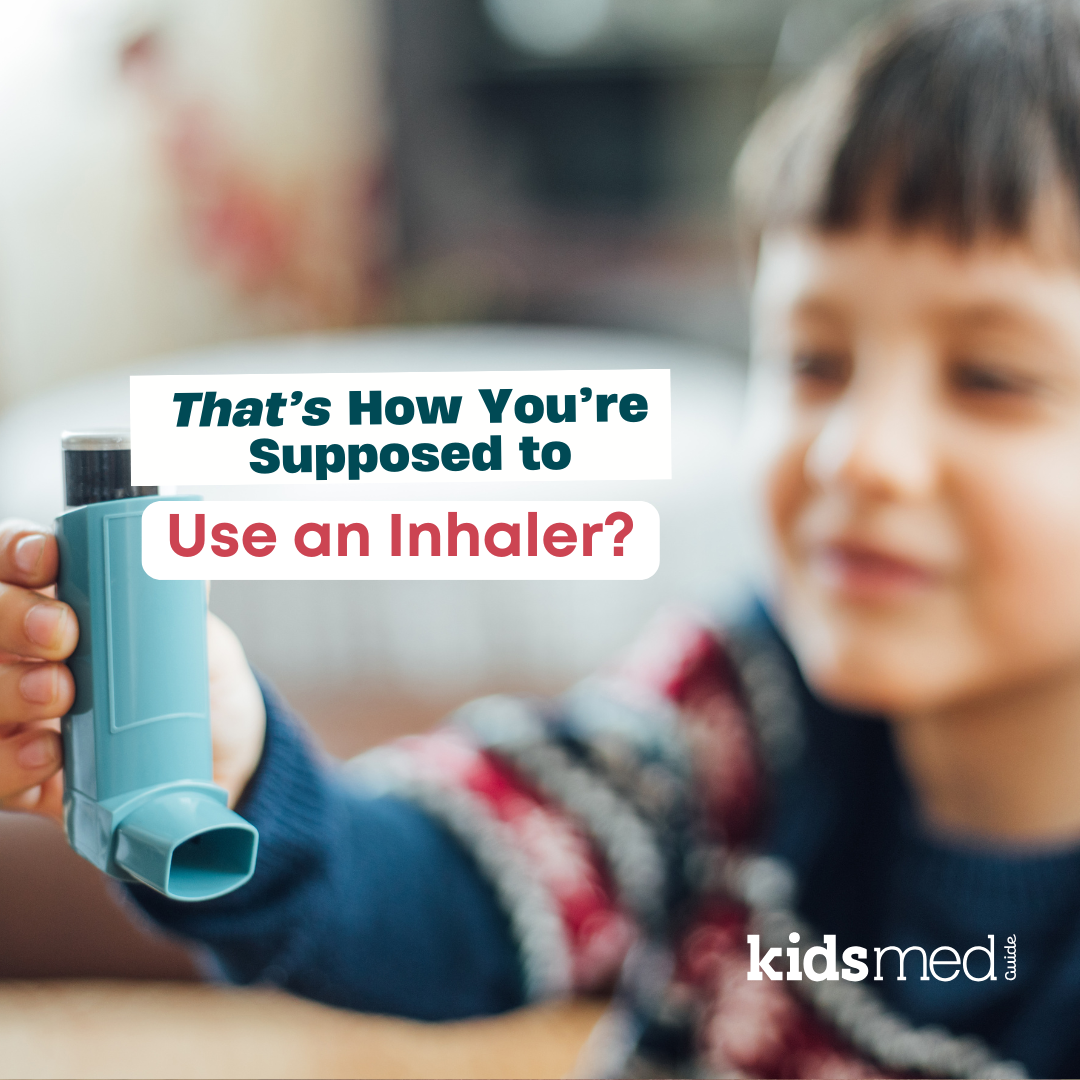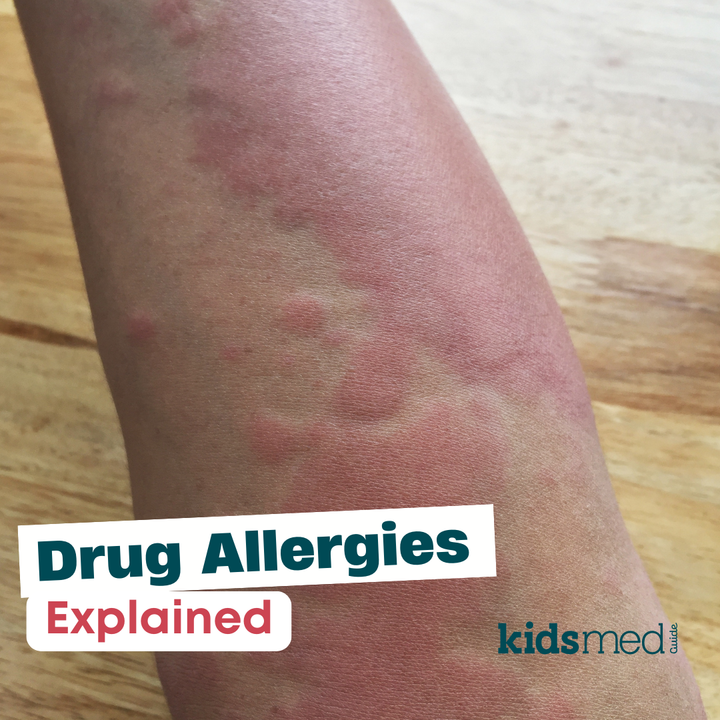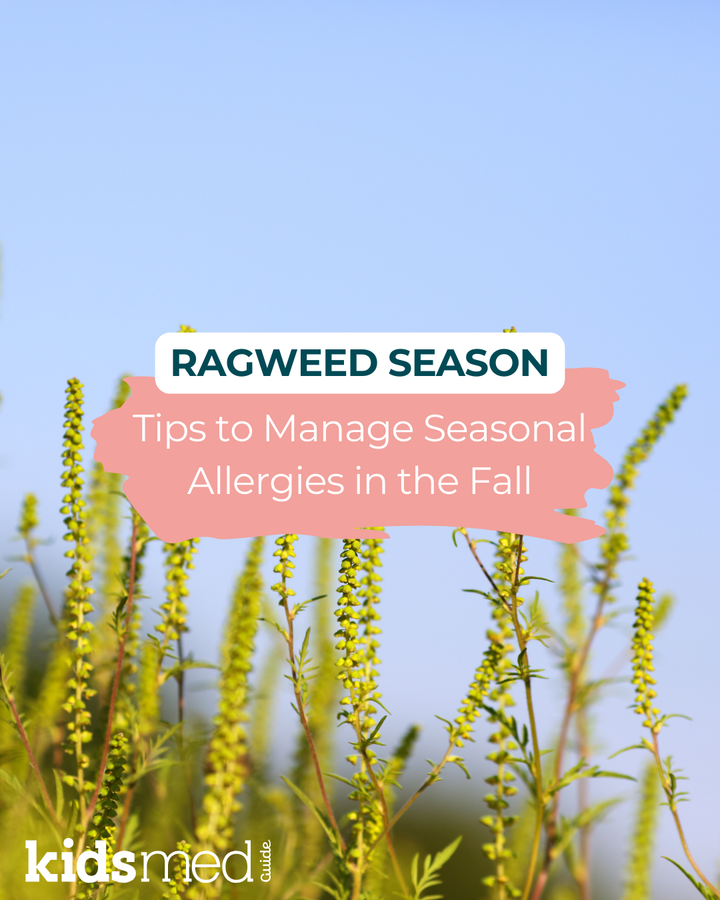Asthma Inhalers for Kids: A Parent’s Guide to Types & Use

Getting a new asthma diagnosis or receiving a prescription for an inhaler or nebulizer can be very overwhelming for parents. Honestly, I felt overwhelmed the first time I learned about inhalers in school and had to practice counseling a patient! I'm sure my preceptor was laughing at me on the inside...
There are many products and devices on the market, and they may function a bit differently. If you're not accustomed to using inhalers, they can feel unfamiliar. The stakes for parents are high—after all, these are meant to help your child breathe!
If you have a new inhaler or nebulizer and are feeling the same way, take a breath (pun intended). This article will help you understand the various types of asthma inhalers for kids, how they function, and what to watch for or ask your pediatrician or pharmacist about.
Why Do Kids Need Inhalers?
Asthma and other lung conditions, such as certain viral or bacterial infections, can cause a child's airway to narrow, swell, or produce mucus, making it difficult for kids to breathe. Inhalers or nebulizers administer medication directly to the lungs, where it is needed.
Depending on the type of medication in the inhaler, delivering medicine directly to the airway can:
- Open up narrow airways
- Minimize swelling and inflammation
- Assist your child in breathing more easily
For asthma, two main types of medications are delivered via inhaler:
- Rescue inhalers, also known as quick-relief inhalers, are used to treat sudden symptoms and breathing difficulties. A common rescue inhaler is albuterol.
- Daily controllers or maintenance inhalers help prevent long-term symptoms. Steroids are commonly used in children.
While asthma is the most common lung condition in children, rescue inhalers may also be used to treat other conditions, such as severe bronchitis or pneumonia, that cause airway swelling and make breathing difficult.
Maintenance inhalers may also be used in conditions such as chronic obstructive pulmonary disease (COPD) or cystic fibrosis. Other types of medication, like long-acting beta-agonists or antibiotics, can also be delivered via an inhalation device.
Standard Advice For All Types of Inhalers
For all types of inhalers, parents should be sure to:
- Read the patient package insert for instructions specific to that inhaler
- Ask your pediatrician, nurse, or pharmacist to demonstrate the correct use
- Closely follow the expiration dates and pay attention to any “dose counters” that indicate how much product is left in your inhaler
- Remember to take the inhaler exactly as prescribed, even if your child is feeling well
- Certain medications may leave a funny taste in the mouth, and your child may want to rinse their mouth out after use
- Patients should always rinse and spit with water after using a steroid inhaler, to prevent thrush
Once you've mastered the basics, it's important to understand the specific type of inhaler or device you have and how to use it! Read on for the most common types of inhalers or inhalation devices your child may be prescribed.
Metered-Dose Inhalers (MDIs)
MDIs typically come with a mouthpiece and a canister containing medicine. When your child presses down on the canister and inhales, the MDI releases a pre-measured puff of medicine.
Each press on the canister (called an actuation) delivers a standard dose of medication. The doses prescribed (i.e., one puff, two puffs) may vary depending on your child's age, weight, or severity of symptoms.
Rescue medications, like albuterol, usually come in MDI form. Some controller medications also come in MDI form.
Using an MDI takes some hand-eye coordination! Instructions may vary depending on your product (always read the insert!), but in general:
- Shake an MDI before use to disperse the medicine inside evenly
- Prime an MDI before first use or if it hasn’t been used in a while
- Priming means shaking the inhaler, removing the cap, and pressing the canister to release 2-4 puffs of medication away from the face
- This step is essential to ensure that medicine is moving through the parts of the inhaler effectively and will reach your child
- Take the cap off before use
- Have your child breathe out and empty their lungs before taking a dose
- Make sure your child tightly seals their lips around the mouthpiece
- Have your child breathe in deeply over a few seconds as you press the canister down to release the medicine
- Once the medicine is inhaled, have your child hold their breath for about 10 seconds or as long as possible
- Remove the inhaler from the child's mouth and have them breathe normally
- Repeat the above steps if multiple puffs are prescribed per dose
Spacers and masks
If your child is too young to coordinate the hand and breath control needed with an MDI, a spacer with a mouthpiece or a mask will be very helpful. A spacer is a chamber that attaches to a metered-dose inhaler (MDI). It traps the medicine released from a puff in the chamber, allowing kids more time to inhale it after the inhaler is actuated.
Older children (varying from child to child, but typically between the ages of 4 or 5 and 8 or 9) can usually use a spacer with a mouthpiece. The mouthpiece is inserted into the mouth, and lips are sealed tightly around it, just as you would with an inhaler.
Younger children (infants through age 4 or 5) can use a spacer with a mask instead of a mouthpiece. This is helpful because younger kids likely won't understand the concept of holding their breath or sealing their lips on a mouthpiece. Or, they may understand but lack the muscle strength or coordination to do so.
If you press the mask over their mouth and nose, they can breathe in and out for 10 seconds without coordinating a breath hold and still receive the entire inhaler dose, which is trapped in the chamber.
Dry Powder Inhalers (DPIs)
DPIs are inhalers that contain a dose of inhaled medicine in powdered form rather than liquid or gas. DPI instructions can vary significantly from product to product. It’s essential to read the package insert carefully and consult with your healthcare provider to ensure you use your inhaler correctly.
Some DPIs require you to activate a dose by crushing a tablet or capsule in the inhaler using the inhaler’s crushing mechanism. For each dose, you may have to insert a tablet or capsule into the inhaled device.
Other DPIs may come pre-loaded with a card containing tablets or pockets of powder, and each inhaler activation will rotate the inhaler to the next dose. Either way, pay attention to your dose counter or packaging to ensure you don’t run out!
While the types of DPIs vary widely, there are some commonalities among them. In general:
- Do not shake a DPI
- Each dose may need to be activated, but DPIs do NOT require “priming” like MDIs do
- DPIs require strong, forceful breathing. Patients must be old enough to put their lips over the mouthpiece and breathe in forcefully.
Nebulizers
Nebulizers convert liquid medication into a fine mist, which your child can inhale through a mask or mouthpiece. They are great for babies, younger children, and anyone with difficulty coordinating the movements or breath control needed for inhalers.
They are also suitable for severe symptoms or when children are too sick to use an inhaler.
- Nebules, commonly called “nebs,” are small plastic vials of liquid medicine
- Doses may vary based on your child’s age, weight, or severity of symptoms. A dose could be ½ of a neb, one full neb, two nebs, etc.
- Some nebs are concentrated and may need to be diluted with an inhaled saline solution
- The neb solution is poured into a “medication cup”
- The nebulizer is the machine that compresses air. This compressed air is sent through the tubing to the medication cup.
- The neb solution in the medication cup becomes a gaseous mist that flows to a face mask
- The face mask is placed over your child’s mouth and nose, and they can breathe normally while the medicine flows into their airway
Nebulizers are a good option for babies and very sick children. They can be a little loud or scary if a child isn’t used to them, so it’s good to have some distractions ready.
The time it takes for a medicine to turn to mist and be delivered to the mask varies depending on the type of nebulizer and the total dose. You're generally looking at at least 10-15 minutes spent with the mask.
Unfortunately, not all inhaled medications are available in nebulizer form. However, rescue medications like albuterol and levalbuterol are available as nebs, as are some controller meds that are most likely to be used by young children.
Choosing the Right Inhaler for Your Child
Choosing the proper inhaler for your child is a shared decision between you and your healthcare provider. Depending on what type of medicine your child needs, you may have options for the kind of inhaler, the use of a spacer or mask, or the option for a nebulizer.
Some things to discuss with the pediatrician include:
- Your child’s age and coordination level
- Your child’s ability to hold their breath for at least 10 seconds
- The type and frequency of asthma or other symptoms
- Whether a spacer or mask would be helpful
- How to use and clean the device properly
- Whether you need something portable for school or on-the-go activities
- Insurance coverage (many plans have preferred medications or tiers)
Helping Your Child Adjust
Making inhalers part of your child’s daily routine helps normalize respiratory care. It's important that your child takes their inhaler exactly as prescribed, even if they are feeling well. If you're encountering resistance (I'm looking at you, toddler moms), try:
- Using a reward chart
- Practicing with a trainer device or letting the child play doctor with a trainer inhaler and a doll or stuffed animal
- Using a fun, special distraction during longer treatments, such as a nebulizer
Final Takeaway
When you receive a new prescription for an inhaler or nebulizer, ask numerous questions, read the package insert, and take the time to become familiar with the device. If it’s an urgent situation, ask your healthcare provider to guide you through the proper setup and use of the inhaler or nebulizer.
There are many helpful videos available online that demonstrate the proper use of an inhaler or nebulizer. Look for an instructional video from a reputable source, like the American Academy of Pediatrics or your local children's hospital. I recommend watching these videos in conjunction with reading the patient insert. With a bit of practice, you’ll be a pro! 😄
The following references were used to compile this information:
Asthma Devices for Kids: How to Use Inhalers & Nebulizers Effectively. (2025, March 25). HealthyChildren.Org. https://www.healthychildren.org/English/health-issues/conditions/allergies-asthma/Pages/asthma-devices-for-kids-how-to-use-inhalers-and-nebulizers-effectively.aspx?_gl=1*1xwjcty*_ga*OTY0NjY2MDE2LjE3NDYwNjQ0MTE.*_ga_FD9D3XZVQQ*MTc0NjA2NDQxMC4xLjEuMTc0NjA2NDU0Ni4wLjAuMA.
Asthma in Children | Boston Children’s Hospital. (n.d.). Retrieved April 30, 2025, from https://www.childrenshospital.org/conditions/asthma
Asthma Medicines for Long-Term Control. (2025, March 25). HealthyChildren.Org. https://www.healthychildren.org/English/health-issues/conditions/allergies-asthma/Pages/Asthma-Medicines-Long-term-Control.aspx?_gl=1*1rvoh18*_ga*OTY0NjY2MDE2LjE3NDYwNjQ0MTE.*_ga_FD9D3XZVQQ*MTc0NjA2NDQxMC4xLjEuMTc0NjA2NDQ2Ni4wLjAuMA.
Medications to Treat Asthma in Children. (2020, January 17). HealthyChildren.Org. https://www.healthychildren.org/English/health-issues/conditions/allergies-asthma/Pages/Medications-Used-to-Treat-Asthma.aspx



